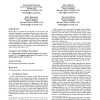157 search results - page 3 / 32 » Detecting Steganographic Content on the Internet |
WWW
2003
ACM
14 years 5 months ago
2003
ACM
The presence of replicas or near-replicas of documents is very common on the Web. Documents may be replicated completely or partially for different reasons (versions, mirrors, etc...
WWW
2006
ACM
14 years 5 months ago
2006
ACM
In this paper, we continue our investigations of "web spam": the injection of artificially-created pages into the web in order to influence the results from search engin...
WAIM
2010
Springer
13 years 3 months ago
2010
Springer
In the Web 2.0 eras, the individual Internet users can also act as information providers, releasing information or making comments conveniently. However, some participants may spre...
TIFS
2008
13 years 4 months ago
2008
Ordered channels, such as those provided by Internet protocol and transmission control protocol protocols, rely on sequence numbers to recover from packet reordering due to network...
ICWE
2004
Springer
13 years 10 months ago
2004
Springer
The recent trend in the Internet traffic is increasing in requests for dynamic and personalized content. To efficiently serve this trend, several serverside and cache-side fragme...

